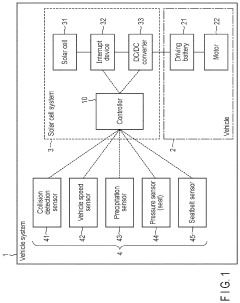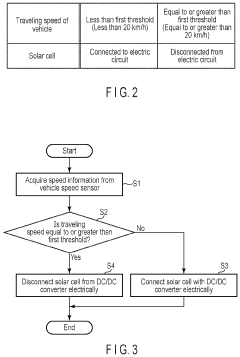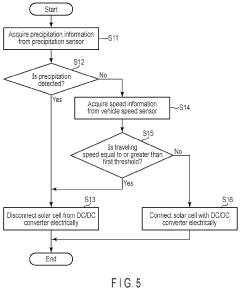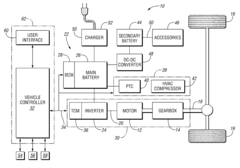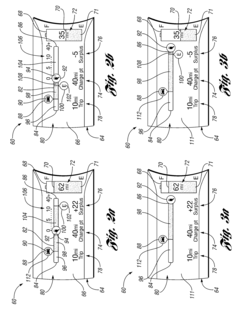How PHEV interfaces with solar panel systems
AUG 14, 20259 MIN READ
Generate Your Research Report Instantly with AI Agent
Patsnap Eureka helps you evaluate technical feasibility & market potential.
PHEV-Solar Integration Background and Objectives
The integration of Plug-in Hybrid Electric Vehicles (PHEVs) with solar panel systems represents a significant advancement in sustainable transportation and energy management. This convergence of automotive and renewable energy technologies has been evolving over the past decade, driven by the global push for cleaner energy solutions and the increasing adoption of electric vehicles.
The primary objective of PHEV-solar integration is to create a symbiotic relationship between vehicle charging and renewable energy generation. This integration aims to reduce the carbon footprint of vehicle operation, decrease reliance on grid electricity, and optimize energy consumption patterns. By harnessing solar power for vehicle charging, this technology seeks to address the challenges of range anxiety and grid dependency that have historically hindered widespread EV adoption.
The evolution of this technology can be traced back to early experiments with solar-powered vehicles in the 1980s. However, it wasn't until the mid-2000s, with advancements in both solar panel efficiency and electric vehicle battery technology, that the concept of integrating PHEVs with home solar systems became commercially viable. The introduction of smart grid technologies and bidirectional charging capabilities in the 2010s further accelerated the development of this integration.
Current technological trends in PHEV-solar integration focus on several key areas. These include the development of more efficient solar panels specifically designed for vehicle integration, advanced energy management systems that optimize power flow between solar arrays, home batteries, and vehicles, and the implementation of Vehicle-to-Grid (V2G) technologies that allow PHEVs to serve as mobile energy storage units.
The market for PHEV-solar integration is driven by increasing environmental awareness, government incentives for clean energy adoption, and the falling costs of both solar panels and electric vehicle technologies. As urban areas grapple with air quality issues and nations strive to meet carbon reduction targets, the integration of PHEVs with solar systems is seen as a crucial component of future sustainable transportation ecosystems.
Looking ahead, the technological goals for PHEV-solar integration include achieving seamless interoperability between vehicles and solar infrastructure, developing standardized protocols for energy exchange, and improving the overall efficiency of the integrated system. There is also a push towards creating more aesthetically pleasing and space-efficient solar charging solutions, such as solar carports and integrated roof tiles, to encourage wider adoption in various urban and suburban settings.
The primary objective of PHEV-solar integration is to create a symbiotic relationship between vehicle charging and renewable energy generation. This integration aims to reduce the carbon footprint of vehicle operation, decrease reliance on grid electricity, and optimize energy consumption patterns. By harnessing solar power for vehicle charging, this technology seeks to address the challenges of range anxiety and grid dependency that have historically hindered widespread EV adoption.
The evolution of this technology can be traced back to early experiments with solar-powered vehicles in the 1980s. However, it wasn't until the mid-2000s, with advancements in both solar panel efficiency and electric vehicle battery technology, that the concept of integrating PHEVs with home solar systems became commercially viable. The introduction of smart grid technologies and bidirectional charging capabilities in the 2010s further accelerated the development of this integration.
Current technological trends in PHEV-solar integration focus on several key areas. These include the development of more efficient solar panels specifically designed for vehicle integration, advanced energy management systems that optimize power flow between solar arrays, home batteries, and vehicles, and the implementation of Vehicle-to-Grid (V2G) technologies that allow PHEVs to serve as mobile energy storage units.
The market for PHEV-solar integration is driven by increasing environmental awareness, government incentives for clean energy adoption, and the falling costs of both solar panels and electric vehicle technologies. As urban areas grapple with air quality issues and nations strive to meet carbon reduction targets, the integration of PHEVs with solar systems is seen as a crucial component of future sustainable transportation ecosystems.
Looking ahead, the technological goals for PHEV-solar integration include achieving seamless interoperability between vehicles and solar infrastructure, developing standardized protocols for energy exchange, and improving the overall efficiency of the integrated system. There is also a push towards creating more aesthetically pleasing and space-efficient solar charging solutions, such as solar carports and integrated roof tiles, to encourage wider adoption in various urban and suburban settings.
Market Analysis for PHEV-Solar Systems
The market for integrated PHEV-solar panel systems is experiencing significant growth, driven by increasing environmental awareness, government incentives, and advancements in both electric vehicle and solar technologies. This synergy between plug-in hybrid electric vehicles (PHEVs) and solar energy systems represents a promising avenue for sustainable transportation and energy management.
Consumer demand for eco-friendly transportation solutions has been steadily rising, with PHEVs offering a bridge between conventional vehicles and fully electric models. The integration of solar panels with PHEVs addresses range anxiety concerns and provides an additional layer of energy independence. This combination appeals to environmentally conscious consumers who seek to reduce their carbon footprint while maintaining the flexibility of hybrid technology.
Market research indicates that early adopters of PHEV-solar systems are primarily homeowners in suburban areas with access to private parking and roof space for solar installations. These consumers are typically middle to upper-income individuals who value sustainability and are willing to invest in long-term energy-saving solutions. As technology costs decrease and efficiency improves, the market is expected to expand to a broader demographic.
The potential market size for PHEV-solar systems is substantial, with projections suggesting significant growth over the next decade. Factors contributing to this growth include the increasing adoption of electric vehicles, falling costs of solar technology, and supportive government policies promoting clean energy and transportation.
Industry analysts predict that the PHEV market will continue to expand, with solar integration becoming an increasingly attractive feature. This trend is supported by the growing number of automotive manufacturers offering solar-compatible PHEVs and the emergence of specialized companies providing aftermarket solar solutions for existing PHEVs.
The market landscape is also influenced by regional factors, with areas experiencing high electricity costs or frequent power outages showing greater interest in PHEV-solar systems. Additionally, regions with abundant sunlight and supportive renewable energy policies are likely to see faster adoption rates.
Challenges in the market include the initial cost of implementation, which can be a barrier for some consumers despite long-term savings. There is also a need for standardization in the interface between PHEVs and solar systems to ensure compatibility across different vehicle models and solar panel manufacturers.
Overall, the market analysis for PHEV-solar systems reveals a growing and dynamic sector with significant potential for expansion. As technology continues to evolve and costs decrease, the integration of PHEVs with solar panel systems is poised to play an increasingly important role in the transition to sustainable transportation and energy solutions.
Consumer demand for eco-friendly transportation solutions has been steadily rising, with PHEVs offering a bridge between conventional vehicles and fully electric models. The integration of solar panels with PHEVs addresses range anxiety concerns and provides an additional layer of energy independence. This combination appeals to environmentally conscious consumers who seek to reduce their carbon footprint while maintaining the flexibility of hybrid technology.
Market research indicates that early adopters of PHEV-solar systems are primarily homeowners in suburban areas with access to private parking and roof space for solar installations. These consumers are typically middle to upper-income individuals who value sustainability and are willing to invest in long-term energy-saving solutions. As technology costs decrease and efficiency improves, the market is expected to expand to a broader demographic.
The potential market size for PHEV-solar systems is substantial, with projections suggesting significant growth over the next decade. Factors contributing to this growth include the increasing adoption of electric vehicles, falling costs of solar technology, and supportive government policies promoting clean energy and transportation.
Industry analysts predict that the PHEV market will continue to expand, with solar integration becoming an increasingly attractive feature. This trend is supported by the growing number of automotive manufacturers offering solar-compatible PHEVs and the emergence of specialized companies providing aftermarket solar solutions for existing PHEVs.
The market landscape is also influenced by regional factors, with areas experiencing high electricity costs or frequent power outages showing greater interest in PHEV-solar systems. Additionally, regions with abundant sunlight and supportive renewable energy policies are likely to see faster adoption rates.
Challenges in the market include the initial cost of implementation, which can be a barrier for some consumers despite long-term savings. There is also a need for standardization in the interface between PHEVs and solar systems to ensure compatibility across different vehicle models and solar panel manufacturers.
Overall, the market analysis for PHEV-solar systems reveals a growing and dynamic sector with significant potential for expansion. As technology continues to evolve and costs decrease, the integration of PHEVs with solar panel systems is poised to play an increasingly important role in the transition to sustainable transportation and energy solutions.
Technical Challenges in PHEV-Solar Interfaces
The integration of Plug-in Hybrid Electric Vehicles (PHEVs) with solar panel systems presents several technical challenges that need to be addressed for seamless operation. One of the primary obstacles is the synchronization of power flow between the solar panels, the vehicle's battery, and the grid. The intermittent nature of solar energy production requires sophisticated power management systems to ensure efficient energy utilization and storage.
Another significant challenge lies in the development of bidirectional charging capabilities. This feature allows PHEVs to not only receive power from solar panels but also feed excess energy back into the grid or home energy systems. Implementing this functionality demands advanced inverter technologies and smart charging algorithms that can handle variable power flows while maintaining grid stability.
The optimization of charging schedules poses another technical hurdle. Coordinating the charging of PHEVs with peak solar production times requires intelligent energy management systems. These systems must consider factors such as solar irradiance forecasts, vehicle usage patterns, and grid demand to maximize the use of solar energy and minimize reliance on grid power.
Compatibility issues between different solar panel systems and PHEV models present additional challenges. Standardization of communication protocols and hardware interfaces is crucial to ensure interoperability across various manufacturers and technologies. This includes developing universal connectors and adapters that can accommodate different charging standards and power outputs.
The integration of energy storage systems to buffer the variability of solar power generation is another technical challenge. These systems must be designed to handle the high power demands of PHEVs while also managing the fluctuating input from solar panels. Developing efficient and cost-effective energy storage solutions that can operate reliably under these conditions is a key area of focus.
Safety and protection mechanisms pose significant technical challenges in PHEV-solar interfaces. Implementing robust safeguards against electrical faults, overcharging, and thermal runaway is critical. This includes developing advanced battery management systems, fault detection algorithms, and isolation mechanisms to ensure the safety of both the vehicle and the connected solar infrastructure.
Lastly, the challenge of scalability and grid integration cannot be overlooked. As the adoption of PHEVs and solar panel systems grows, the impact on the electrical grid becomes more pronounced. Developing smart grid technologies that can manage the increased load and bidirectional power flow while maintaining grid stability is a complex technical challenge that requires ongoing research and development efforts.
Another significant challenge lies in the development of bidirectional charging capabilities. This feature allows PHEVs to not only receive power from solar panels but also feed excess energy back into the grid or home energy systems. Implementing this functionality demands advanced inverter technologies and smart charging algorithms that can handle variable power flows while maintaining grid stability.
The optimization of charging schedules poses another technical hurdle. Coordinating the charging of PHEVs with peak solar production times requires intelligent energy management systems. These systems must consider factors such as solar irradiance forecasts, vehicle usage patterns, and grid demand to maximize the use of solar energy and minimize reliance on grid power.
Compatibility issues between different solar panel systems and PHEV models present additional challenges. Standardization of communication protocols and hardware interfaces is crucial to ensure interoperability across various manufacturers and technologies. This includes developing universal connectors and adapters that can accommodate different charging standards and power outputs.
The integration of energy storage systems to buffer the variability of solar power generation is another technical challenge. These systems must be designed to handle the high power demands of PHEVs while also managing the fluctuating input from solar panels. Developing efficient and cost-effective energy storage solutions that can operate reliably under these conditions is a key area of focus.
Safety and protection mechanisms pose significant technical challenges in PHEV-solar interfaces. Implementing robust safeguards against electrical faults, overcharging, and thermal runaway is critical. This includes developing advanced battery management systems, fault detection algorithms, and isolation mechanisms to ensure the safety of both the vehicle and the connected solar infrastructure.
Lastly, the challenge of scalability and grid integration cannot be overlooked. As the adoption of PHEVs and solar panel systems grows, the impact on the electrical grid becomes more pronounced. Developing smart grid technologies that can manage the increased load and bidirectional power flow while maintaining grid stability is a complex technical challenge that requires ongoing research and development efforts.
Current PHEV-Solar Interface Solutions
01 Power management systems for PHEVs
Advanced power management systems are crucial for optimizing the performance of plug-in hybrid electric vehicles. These systems control the distribution of power between the electric motor and internal combustion engine, manage battery charging, and improve overall energy efficiency. They also incorporate intelligent algorithms to predict and adapt to driving conditions, enhancing the vehicle's range and fuel economy.- Power management systems for PHEVs: Advanced power management systems are crucial for optimizing the performance of plug-in hybrid electric vehicles. These systems control the distribution of power between the electric motor and internal combustion engine, manage battery charging, and improve overall energy efficiency. They often incorporate intelligent algorithms to predict driving conditions and adjust power output accordingly.
- Charging infrastructure and methods for PHEVs: Developing efficient charging infrastructure is essential for the widespread adoption of PHEVs. This includes the design of charging stations, integration with smart grids, and implementation of fast-charging technologies. Advanced charging methods, such as wireless charging and vehicle-to-grid systems, are also being explored to enhance convenience and grid stability.
- Drivetrain and transmission systems for PHEVs: Innovative drivetrain and transmission systems are being developed to improve the performance and efficiency of PHEVs. These include advanced electric motors, regenerative braking systems, and hybrid transmissions that can seamlessly switch between electric and combustion power. The goal is to maximize energy recovery and minimize power losses during various driving conditions.
- Battery technology and management for PHEVs: Advancements in battery technology are crucial for improving the range and performance of PHEVs. This includes the development of high-capacity batteries, thermal management systems, and battery monitoring technologies. Efficient battery management systems are designed to optimize charging cycles, extend battery life, and ensure safe operation under various conditions.
- Control strategies and algorithms for PHEVs: Sophisticated control strategies and algorithms are being developed to optimize the operation of PHEVs. These include predictive control systems that use real-time data and machine learning to anticipate driving conditions and adjust vehicle parameters accordingly. Advanced driver assistance systems and autonomous driving technologies are also being integrated to enhance the overall performance and efficiency of PHEVs.
02 Charging infrastructure and methods for PHEVs
Developing efficient charging infrastructure is essential for the widespread adoption of PHEVs. This includes the design of charging stations, smart grid integration, and fast-charging technologies. Advanced charging methods, such as wireless charging and vehicle-to-grid (V2G) systems, are being explored to enhance convenience and grid stability.Expand Specific Solutions03 Battery technology advancements for PHEVs
Improvements in battery technology are critical for enhancing the performance and range of PHEVs. This includes developing high-energy-density batteries, improving thermal management systems, and extending battery life. Research is also focused on reducing battery costs and exploring alternative materials to make PHEVs more affordable and sustainable.Expand Specific Solutions04 Drivetrain and transmission systems for PHEVs
Innovative drivetrain and transmission systems are being developed to optimize the integration of electric motors and internal combustion engines in PHEVs. These systems aim to improve power delivery, reduce energy losses, and enhance overall vehicle efficiency. Advanced control strategies and multi-speed transmissions are being explored to maximize the benefits of both power sources.Expand Specific Solutions05 Regenerative braking and energy recovery in PHEVs
Regenerative braking systems play a crucial role in improving the energy efficiency of PHEVs. These systems capture and convert kinetic energy during deceleration into electrical energy, which is then stored in the battery. Advanced regenerative braking technologies are being developed to maximize energy recovery and extend the electric range of PHEVs.Expand Specific Solutions
Key Players in PHEV and Solar Industries
The integration of Plug-in Hybrid Electric Vehicles (PHEVs) with solar panel systems is an emerging technology at the intersection of automotive and renewable energy sectors. This market is in its early growth stage, with increasing interest from both consumers and manufacturers. The global PHEV market size is projected to expand significantly in the coming years, driven by environmental concerns and government incentives. Technologically, the interface between PHEVs and solar systems is still evolving, with companies like Ford, Sono Motors, and BMW leading innovation. These firms are developing advanced energy management systems and bidirectional charging capabilities to optimize the synergy between PHEVs and solar infrastructure, indicating a gradual progression towards technological maturity in this niche.
Sono Motors GmbH
Technical Solution: Sono Motors has pioneered a unique approach to PHEV-solar integration with their solar-powered electric vehicle technology. Their system incorporates solar cells directly into the vehicle's body panels, allowing for continuous charging while driving or parked[13]. For PHEVs, Sono Motors has adapted this technology to create a hybrid solar-electric powertrain that can significantly extend the vehicle's electric range. The system uses lightweight, flexible solar cells that can be molded to fit various vehicle shapes without compromising aerodynamics[15]. Sono's energy management system optimizes the use of solar power, prioritizing it for driving or storing it in the battery for later use. The company has also developed a mobile app that provides real-time data on solar generation and energy consumption, allowing users to maximize their use of solar power[17].
Strengths: Innovative vehicle-integrated solar technology, potential for continuous charging without dedicated infrastructure. Weaknesses: Solar generation capacity may be limited by vehicle surface area, effectiveness highly dependent on environmental conditions.
Ford Motor Co.
Technical Solution: Ford has developed an innovative PHEV-solar integration system that optimizes energy management between the vehicle and home solar panels. Their solution incorporates a bi-directional charging system, allowing the PHEV to both charge from and discharge to the home's solar array[1]. The system uses advanced algorithms to predict solar generation and vehicle usage patterns, ensuring optimal energy flow[3]. Ford's technology also includes a smart inverter that can prioritize solar energy for vehicle charging during peak sunlight hours, while utilizing excess energy to power the home or feed back to the grid[5]. This integrated approach maximizes the use of renewable energy and reduces overall carbon footprint.
Strengths: Seamless integration with home energy systems, optimized energy management, and potential for reduced electricity costs. Weaknesses: Requires significant infrastructure investment and may have limited effectiveness in areas with low solar potential.
Core Technologies for PHEV-Solar Integration
Solar cell system and vehicle system
PatentActiveUS20240092181A1
Innovation
- A solar cell system with a controller that electrically disconnects the solar cell from the DC/DC converter when the vehicle's speed exceeds a threshold, preventing electrical contact and shock, and also considers precipitation and occupancy for fine-tuned control.
Information Display System And Method
PatentActiveUS20120179319A1
Innovation
- A display control system that includes a controller and display, which uses color schemes to indicate estimated vehicle range, energy surplus or deficit, and instantaneous energy consumption, providing visual feedback through a battery gauge and trip gauge to inform drivers about their vehicle's range and energy status relative to target destinations.
Regulatory Framework for PHEV-Solar Integration
The regulatory framework for PHEV-Solar integration is a complex and evolving landscape that varies across different jurisdictions. At the federal level in the United States, the Federal Energy Regulatory Commission (FERC) has established guidelines for interconnection standards and net metering policies. These regulations aim to ensure the safe and efficient integration of distributed energy resources, including PHEV-solar systems, into the existing power grid.
State-level regulations play a crucial role in shaping the PHEV-solar integration landscape. Many states have implemented Renewable Portfolio Standards (RPS) that mandate a certain percentage of electricity generation from renewable sources. These standards often include specific provisions for solar energy and can indirectly impact PHEV-solar integration by creating incentives for solar adoption.
Net metering policies, which allow consumers to sell excess electricity back to the grid, are particularly relevant for PHEV-solar integration. While net metering regulations vary by state, they generally enable homeowners with solar panels to offset their electricity consumption, including that used for charging PHEVs. Some states have introduced time-of-use (TOU) rates, which can incentivize PHEV owners to charge their vehicles during off-peak hours when solar generation is abundant.
Building codes and permitting processes also play a significant role in PHEV-solar integration. Many jurisdictions have updated their building codes to accommodate solar panel installations and EV charging infrastructure. Some cities and states have gone further by mandating solar panels on new constructions or requiring EV-ready wiring in residential and commercial buildings.
Safety standards and certifications are critical components of the regulatory framework. Organizations such as Underwriters Laboratories (UL) and the National Electrical Code (NEC) provide guidelines for the safe installation and operation of solar PV systems and EV charging equipment. These standards ensure that PHEV-solar integrations meet rigorous safety requirements and are compatible with existing electrical systems.
Environmental regulations, particularly those related to emissions reduction and air quality, indirectly support PHEV-solar integration. Policies such as the Corporate Average Fuel Economy (CAFE) standards and Zero Emission Vehicle (ZEV) mandates encourage the adoption of PHEVs and, by extension, their integration with renewable energy sources like solar power.
As the technology and market for PHEV-solar integration continue to evolve, regulatory frameworks are likely to adapt. Policymakers are increasingly focusing on grid modernization efforts, which include provisions for advanced metering infrastructure and smart grid technologies. These initiatives aim to create a more flexible and resilient power system capable of accommodating the growing integration of PHEVs and distributed solar generation.
State-level regulations play a crucial role in shaping the PHEV-solar integration landscape. Many states have implemented Renewable Portfolio Standards (RPS) that mandate a certain percentage of electricity generation from renewable sources. These standards often include specific provisions for solar energy and can indirectly impact PHEV-solar integration by creating incentives for solar adoption.
Net metering policies, which allow consumers to sell excess electricity back to the grid, are particularly relevant for PHEV-solar integration. While net metering regulations vary by state, they generally enable homeowners with solar panels to offset their electricity consumption, including that used for charging PHEVs. Some states have introduced time-of-use (TOU) rates, which can incentivize PHEV owners to charge their vehicles during off-peak hours when solar generation is abundant.
Building codes and permitting processes also play a significant role in PHEV-solar integration. Many jurisdictions have updated their building codes to accommodate solar panel installations and EV charging infrastructure. Some cities and states have gone further by mandating solar panels on new constructions or requiring EV-ready wiring in residential and commercial buildings.
Safety standards and certifications are critical components of the regulatory framework. Organizations such as Underwriters Laboratories (UL) and the National Electrical Code (NEC) provide guidelines for the safe installation and operation of solar PV systems and EV charging equipment. These standards ensure that PHEV-solar integrations meet rigorous safety requirements and are compatible with existing electrical systems.
Environmental regulations, particularly those related to emissions reduction and air quality, indirectly support PHEV-solar integration. Policies such as the Corporate Average Fuel Economy (CAFE) standards and Zero Emission Vehicle (ZEV) mandates encourage the adoption of PHEVs and, by extension, their integration with renewable energy sources like solar power.
As the technology and market for PHEV-solar integration continue to evolve, regulatory frameworks are likely to adapt. Policymakers are increasingly focusing on grid modernization efforts, which include provisions for advanced metering infrastructure and smart grid technologies. These initiatives aim to create a more flexible and resilient power system capable of accommodating the growing integration of PHEVs and distributed solar generation.
Environmental Impact Assessment
The integration of Plug-in Hybrid Electric Vehicles (PHEVs) with solar panel systems presents a significant opportunity for reducing the environmental impact of transportation. This synergy between automotive and renewable energy technologies has the potential to substantially decrease greenhouse gas emissions and reliance on fossil fuels.
When PHEVs interface with solar panel systems, they can charge their batteries using clean, renewable energy. This process eliminates the indirect emissions associated with grid-based charging, which often relies on a mix of energy sources, including fossil fuels. By utilizing solar power, PHEVs can achieve true zero-emission operation during electric-only driving modes, significantly reducing their carbon footprint.
The environmental benefits extend beyond just emissions reduction. Solar-powered charging of PHEVs can help alleviate strain on the electrical grid, particularly during peak demand periods. This load balancing effect can reduce the need for additional power plants, thereby mitigating the environmental impact associated with energy infrastructure expansion.
Furthermore, the combination of PHEVs and solar panels promotes energy independence and resilience. By generating and storing their own energy, households and businesses can reduce their reliance on centralized power systems, which are often vulnerable to disruptions and heavily dependent on non-renewable resources.
The life cycle assessment of PHEVs charged by solar panels shows a marked improvement in overall environmental performance compared to conventional vehicles or even PHEVs charged from the grid. The reduction in lifecycle emissions encompasses not only the operational phase but also considers the manufacturing and end-of-life stages of both the vehicle and the solar panel system.
However, it is important to consider the environmental impact of producing solar panels and PHEV batteries. While these technologies significantly reduce operational emissions, their manufacturing processes can be resource-intensive and potentially polluting. Ongoing advancements in production techniques and materials are continually improving the sustainability of these components.
The widespread adoption of PHEV-solar panel interfaces could lead to broader positive environmental outcomes. As more consumers embrace this technology, it could drive further innovation in renewable energy and energy storage solutions, creating a virtuous cycle of technological advancement and environmental improvement.
In conclusion, the environmental impact assessment of PHEVs interfacing with solar panel systems reveals a promising pathway towards sustainable transportation. While challenges remain, particularly in manufacturing processes, the overall benefits in terms of emissions reduction, energy independence, and grid stability present a compelling case for the continued development and adoption of this integrated technology.
When PHEVs interface with solar panel systems, they can charge their batteries using clean, renewable energy. This process eliminates the indirect emissions associated with grid-based charging, which often relies on a mix of energy sources, including fossil fuels. By utilizing solar power, PHEVs can achieve true zero-emission operation during electric-only driving modes, significantly reducing their carbon footprint.
The environmental benefits extend beyond just emissions reduction. Solar-powered charging of PHEVs can help alleviate strain on the electrical grid, particularly during peak demand periods. This load balancing effect can reduce the need for additional power plants, thereby mitigating the environmental impact associated with energy infrastructure expansion.
Furthermore, the combination of PHEVs and solar panels promotes energy independence and resilience. By generating and storing their own energy, households and businesses can reduce their reliance on centralized power systems, which are often vulnerable to disruptions and heavily dependent on non-renewable resources.
The life cycle assessment of PHEVs charged by solar panels shows a marked improvement in overall environmental performance compared to conventional vehicles or even PHEVs charged from the grid. The reduction in lifecycle emissions encompasses not only the operational phase but also considers the manufacturing and end-of-life stages of both the vehicle and the solar panel system.
However, it is important to consider the environmental impact of producing solar panels and PHEV batteries. While these technologies significantly reduce operational emissions, their manufacturing processes can be resource-intensive and potentially polluting. Ongoing advancements in production techniques and materials are continually improving the sustainability of these components.
The widespread adoption of PHEV-solar panel interfaces could lead to broader positive environmental outcomes. As more consumers embrace this technology, it could drive further innovation in renewable energy and energy storage solutions, creating a virtuous cycle of technological advancement and environmental improvement.
In conclusion, the environmental impact assessment of PHEVs interfacing with solar panel systems reveals a promising pathway towards sustainable transportation. While challenges remain, particularly in manufacturing processes, the overall benefits in terms of emissions reduction, energy independence, and grid stability present a compelling case for the continued development and adoption of this integrated technology.
Unlock deeper insights with Patsnap Eureka Quick Research — get a full tech report to explore trends and direct your research. Try now!
Generate Your Research Report Instantly with AI Agent
Supercharge your innovation with Patsnap Eureka AI Agent Platform!
